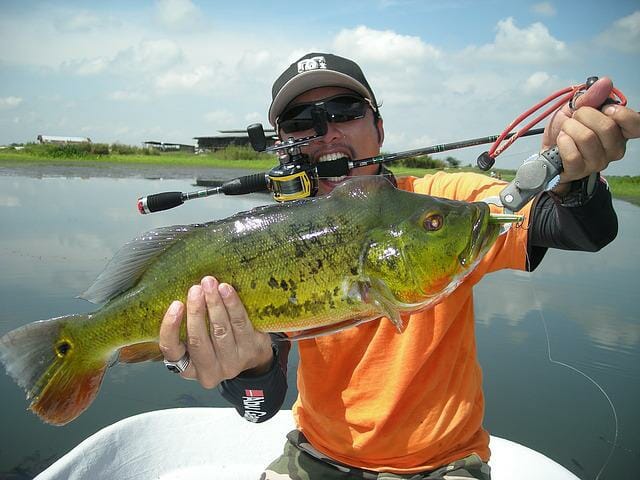What Is a Peacock Bass: Get to Know More About This Species

Peacock bass appears in warm freshwater lakes and reservoirs throughout the United States. These beautiful fish are typically shy and difficult to catch, but they make for an exciting addition to your freshwater fishing.
The peacock bass cichlid is a popular fish in the aquarium trade. They are easy to keep, hardy and colorful. They can reach up to 3.3 feet in length and are native to the Amazon and Orinoco basins.
Table of Contents
Species Overview
Appearance
The peacock bass has a broad, flattened head with a prominent snout and large eyes. Their body is long and thin, with very long tails. They typically have bright vertical stripes down the length of their body and on their fins, and around their eyes. They are peaceful fish and make good additions to any aquarium, but they can be aggressive when they feel threatened or defend their territory.
Lifespan
The peacock bass can live up to 10 years in captivity. They are native to warm freshwater lakes and reservoirs, so they do well in most environments. However, they may not tolerate colder climates or areas with a lot of vegetation.
Size
Peacock bass cichlids are tropical fish that can grow to be 2-3 inches in size when they’re small. They have a torpedo-shaped body and an elongated head covered in bright blue, green, or purple scales. These fish are active and playful and make excellent additions to any aquarium. They are also moderately fast-growing cichlid. They will reach 12-14 inches during the first 16-18 months.
Natural Habitat

The peacock bass is native to the Amazon and Orinoco basins and rivers of the Guianas in tropical South America. It is a popular freshwater fish that is found in many different habitats. They are commonly found in slow-moving streams and rivers, but they can also be found in large lakes. The peacock bass is a very versatile fish and can live in many different types of water.
Availability
There are several different types of peacock bass, each with its unique features. One of the most common types is the blue peacock bass, known for its brightly-colored body and fins. Other types include the golden peacock bass, which has a more golden coloration, and the green peacock bass, which has a more green coloration. These fish are beautiful additions to any aquarium, and they all vary in their hunting and eating habits.
Peacock Bass Care in Captivity
The peacock bass is a popular fish that needs special care to thrive. A peacock bass aquarium should be large enough for the fish to swim around in, and the tank should have a variety of plants and rocks for the fish to hide amongst. The aquarium should also have a tight-fitting cover so that the fish cannot escape. Peacock bass eats live insects, so providing them with plenty of these creatures is essential.
Tank Requirements
Peacock bass is hardy and easy to keep, but they require specific tank requirements. A tank that is at least 100 gallons. They like a moderate to high water temperature of 75 to 81 degrees Fahrenheit (23 to 27 degrees Celsius) and a pH level of 6.5-7.5. They also require plenty of plant cover to create an environment that is both shady and light. Finally, they need plenty of oxygenation, so a well-filtered tank is essential. When adding the peacock bass to your aquarium, it is necessary to ensure that their new home has enough gravel and rocks to hide as they adjust to their new surroundings.
Diet and Feeding Schedule
The peacock bass is a popular aquarium fish that requires a varied diet to stay healthy. A good diet for this fish includes live and frozen foods such as bloodworms, brine shrimp, and daphnia. You should supplement a peacock bass diet with flakes, granules, or pellets to provide essential proteins and vitamins. In addition, You should feed the fish small amounts of food every several hours.
Tankmates
The Peacock Bass is a popular fish that can be kept in an aquarium with other fish species. When choosing tank mates for the peacock bass, it is essential to consider their compatibility. These fish are generally peaceful and should be kept with smaller, less aggressive fishes. Some good choices for tank mates include Arowanas, Stingrays, and Other Cichlids.
The Redtail Catfish
A few different peacock bass tank mates can be a great addition to any aquarium. One of the more popular options is the redtail catfish. These fish are omnivorous and eat various foods, including live and frozen marine invertebrates, terrestrial invertebrates, and even small fish. They can be lively and entertaining fish in an aquarium, and their vibrant colors will add some interest to your tank.
Freshwater Stingrays
The freshwater stingrays are good for tank mates for the peacock bass. These fish are gentle and peaceful, making them a great option if you’re looking for a non-aggressive addition to your aquarium. However, they can be difficult to keep separate from other types of fish in captivity, but once they get used to their new home, they should be relatively easy to care for.
Breeding
The peacock bass is a popular fish that You can breed in captivity. Having a well-rounded and healthy aquarium is essential when generating peacock bass. The aquarium should have plenty of plants and rocks for the fish to hide among and enough room to swim around. The male peacock bass will aggressively defend his territory from other males, so it is essential to keep several females in the tank so that there is competition for the male’s attention.